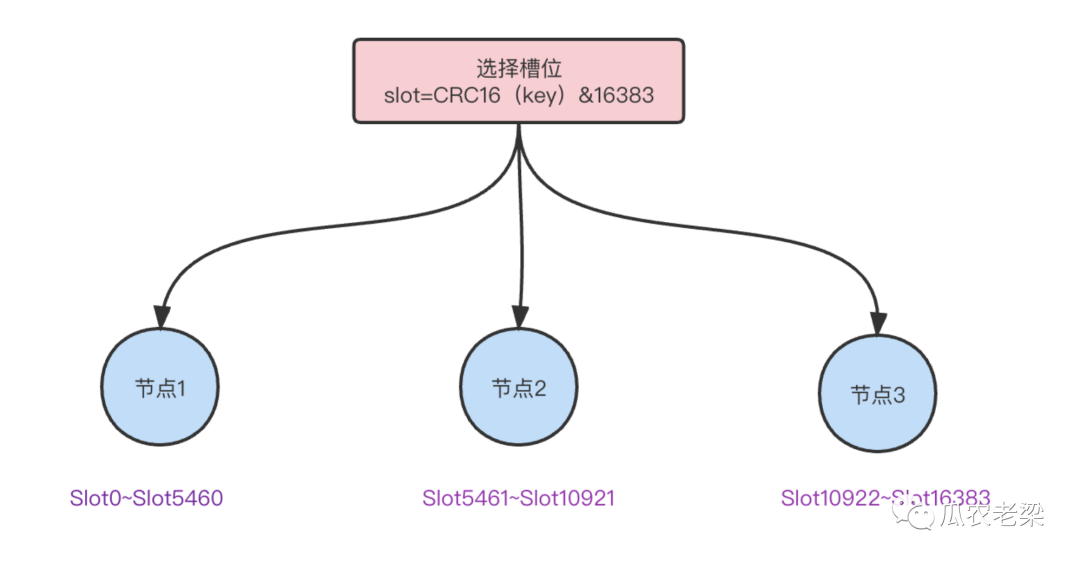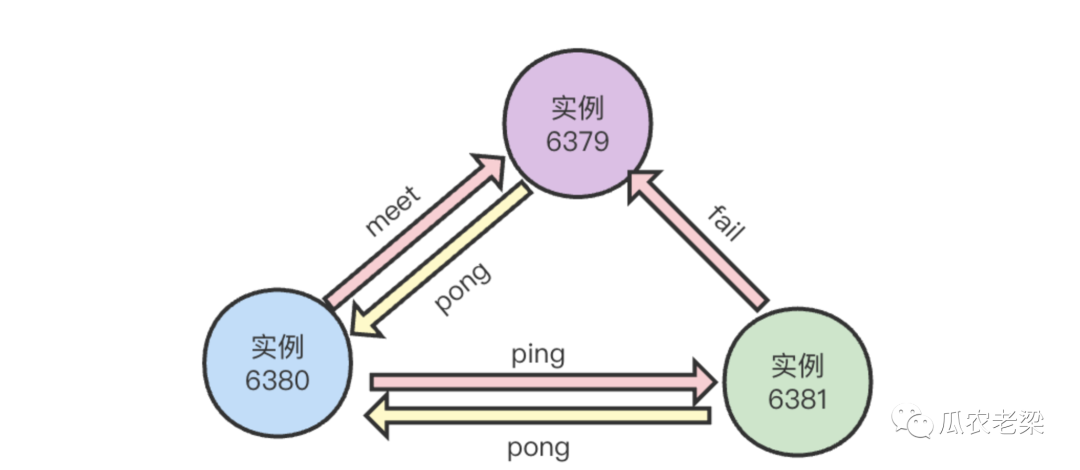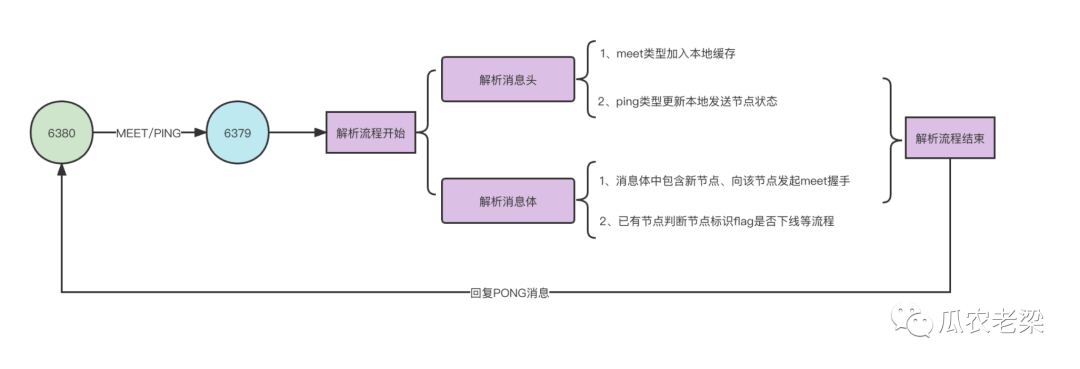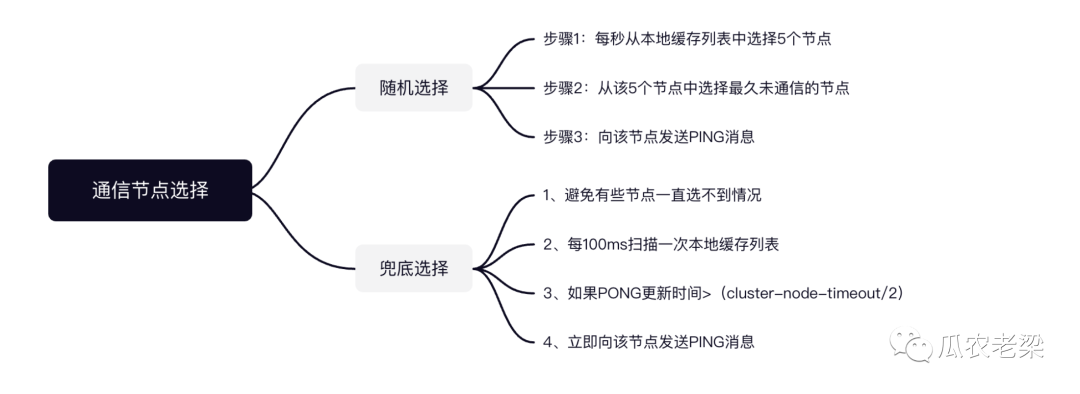为了应对流量并发瓶颈,以及方便数据迁移与扩容,数据分片方式是常用的解决方式。
Kafka的分区(partition)、RocketMQ的队列(Queue)、Elasticsearch的主分片/副本(shard)、数据库的分库分表等,均采用数据分片思想应对高并发流量。
Redis的集群模式也不例外,采用虚拟槽slot实现数据分片。
Redis的槽位范围0~16383,共16384个槽位。
Redis Cluster中每个节点负责一部分槽数量,分配算法:slot=CRC16(key)&16383。
槽位分配与选择示意图如下:

1、Gosisp协议类型
节点通信使用Gosisp协议,消息类型有:ping消息、pong消息、meet消息、fail消息。

通信端口=节点端口+10000。
每个节点周期性的选择几个节点发送ping消息。
2.消息头格式
消息头的结构在clusterMsg中,具体属性如下:
字段 |
说明 |
简述 |
char sig[4] |
Signature "RCmb" (Redis Cluster message bus). |
信号签名 |
uint32_t totlen |
Total length of this message |
消息长度 |
uint16_t ver |
Protocol version, currently set to 1 |
协议版本 |
uint16_t port |
TCP base port number |
端口信息 |
uint16_t type |
Message type |
消息类型,ping、meet、pong等 |
uint16_t count |
Only used for some kind of messages |
消息体包含的节点数量 |
uint64_t currentEpoch |
The epoch accordingly to the sending node |
发送节点的纪元(epoch)配置 |
uint64_t configEpoch |
The config epoch if it's a master, or the last epoch advertised by its master if it is a slave |
主从节点中,主节点的纪元配置 |
uint64_t offset |
Master replication offset if node is a master or processed replication offset if node is a slave |
复制偏移量 |
char sender[CLUSTER_NAMELEN] |
Name of the sender node |
发送节点的nodeId信息 |
unsigned char myslots[CLUSTER_SLOTS/8] |
myslots info |
发送节点负责的槽位信息 |
char slaveof[CLUSTER_NAMELEN] |
从节点的nodeId信息 |
|
char myip[NET_IP_STR_LEN] |
Sender IP, if not all zeroed |
发送者IP |
uint16_t extensions |
Number of extensions sent along with this packet |
扩展信息 |
char notused1[30] |
30 bytes reserved for future usage |
保留30个字节扩展供未来使用 |
uint16_t pport |
Sender TCP plaintext port, if base port is TLS |
如果基础端口为TLS,TCP的明文端口 |
uint16_t cport |
Sender TCP cluster bus port |
发送者TCP集群总线端口 |
uint16_t flags |
Sender node flags |
发送节点标识,区分主从以及是否下线 |
unsigned char state |
Cluster state from the POV of the sender |
发送者角度的集群状态 |
unsigned char mflags[3] |
Message flags: CLUSTERMSG_FLAG[012]_... |
消息标识 |
union clusterMsgData data |
消息体正文 |
3.消息体格式
消息体clusterMsgData结构如下:
union clusterMsgData {
/* PING, MEET and PONG */
struct {
/* Array of N clusterMsgDataGossip structures */
clusterMsgDataGossip gossip[1];
/* Extension data that can optionally be sent for ping/meet/pong
* messages. We can't explicitly define them here though, since
* the gossip array isn't the real length of the gossip data. */
} ping;
/* FAIL */
struct {
clusterMsgDataFail about;
} fail;
/* PUBLISH */
struct {
clusterMsgDataPublish msg;
} publish;
/* UPDATE */
struct {
clusterMsgDataUpdate nodecfg;
} update;
/* MODULE */
struct {
clusterMsgModule msg;
} module;
};
备注:clusterMsgDataGossip:PING, MEET and PONG采用的消息结构体,详细如下。
typedef struct {
char nodename[CLUSTER_NAMELEN];
uint32_t ping_sent;
uint32_t pong_received;
char ip[NET_IP_STR_LEN]; /* IP address last time it was seen */
uint16_t port; /* base port last time it was seen */
uint16_t cport; /* cluster port last time it was seen */
uint16_t flags; /* node->flags copy */
uint16_t pport; /* plaintext-port, when base port is TLS */
uint16_t notused1;
} clusterMsgDataGossip;
1.节点通信流程
两个节点之间发送MEET/PING消息,回复PONG消息的流程如下。

2.通信节点选择
Gosisp协议PING/PONG通信时,具体选择哪个节点发起通信?
每秒从本地实例列表选择5个节点,在这5个节点中选择最久没有通信的实例,向该实例发送PING消息。
避免一些实例节点一直选不到,会有一个定时任务扫描兜底措施。
集群内部每秒10次的固定频率扫描本地缓存节点列表,也就是每100ms一次。
如果节点:PONG更新时间>(cluster-node-timeout/2)立即向该节点发送PING消息。
cluster-node-timeout是判定实例故障的心跳超时时间,默认15秒。



 暂无任何评论,欢迎留下你的想法
暂无任何评论,欢迎留下你的想法


